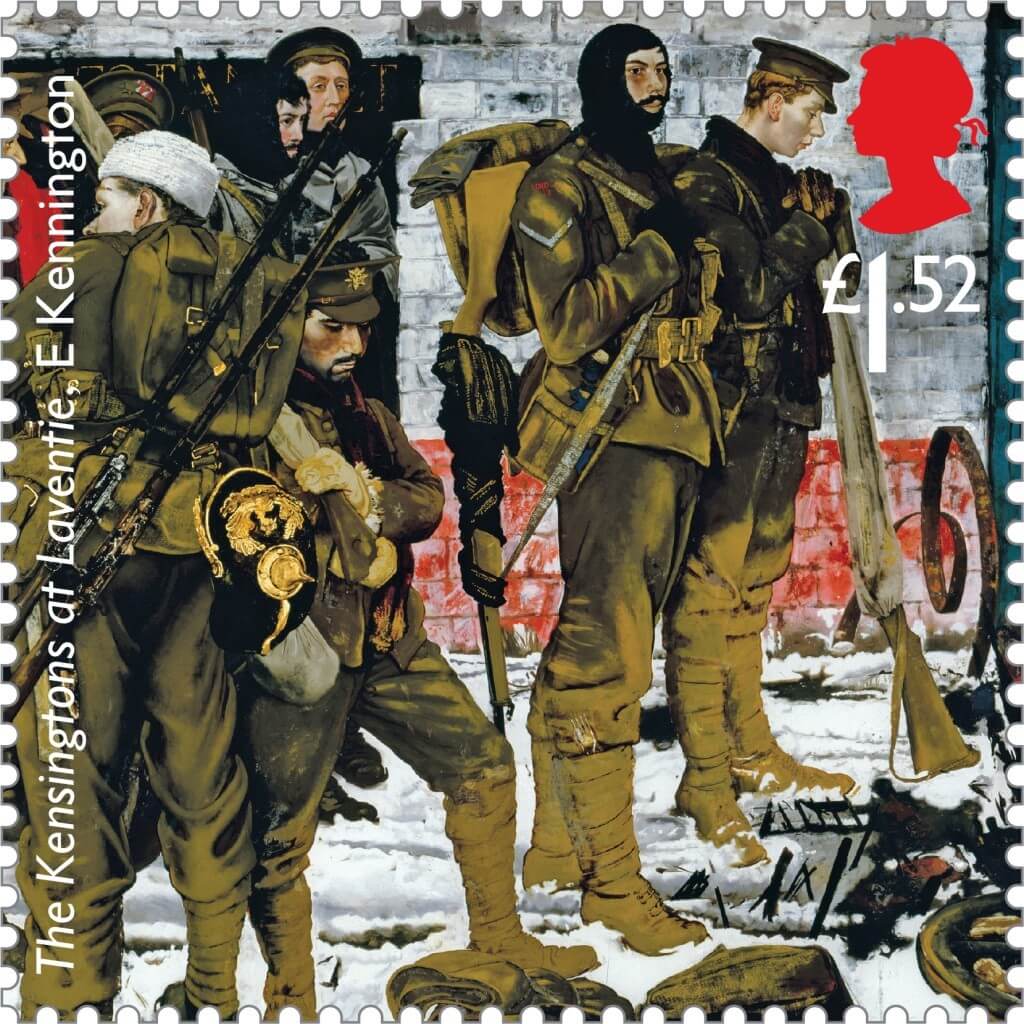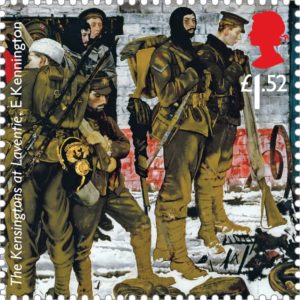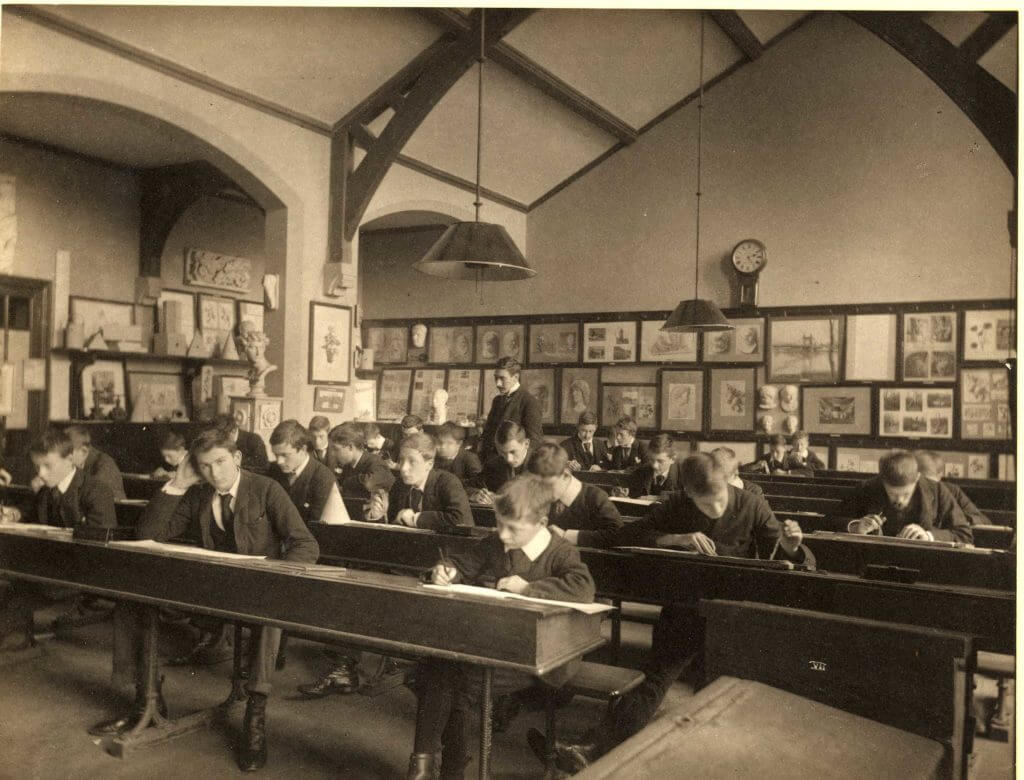

“If I am of use, it is in depicting British soldiers in their truest and noblest aspect; of that work I will never tire”.
‘The Kensingtons at Laventie’ by Eric Kennington depicts No7 Platoon C Company in December 1914 and features nine named soldiers including Private Eric Kennington.
We believe there are two other Old Paulines in the painting as they have the same surnames and served in the Kensington & London Regiments before commissioning. They are Private M Slade then Captain P P M Slade (Kensingtons (TF) and Yorks & Lancaster Regiment) and Private ‘Sweeney’ Todd then Lieutenant M C B Todd MC (London Regiment attached to the Royal Engineers).
This is what we know of their school careers:
Philip Percy Melville Slade was born on 15 February 1896 and entered St Paul’s in the summer of 1908, from Mr Wagner (a private tutor) His address on entry was in South Kensington and his father was a stockbroker. He left school from class UVa in July 1911 after gaining a Junior scholarship in September 1910.
Montague Charles Brown Todd was born in 1892 and entered St Paul’s in the spring of 1907 from Colet Court. His address on entry was in Bedford Park where his father was a chemist. He left school from class Sc8b in July 1912. He was in A Club and played rugby. We also know that he died in 1969 in Kingston upon Thames.

Eric Henri Kennington RA (12 March 1888 – 13 April 1960) was an English sculptor, artist and illustrator, and a war artist in both World Wars.
Kennington was born in Chelsea, London, the second son of the genre and portrait painter, Thomas Benjamin Kennington (1856–1916), a founder member of the New English Art Club. After St Paul’s School Eric attended the Lambeth School of Art.
Ginny Dawe-Woodings, the St Paul’s School archivist researched Kennington, EH’s school reports.
In March 1901, his Mathematics master reports that Eric is “good, very restless”.
By December 1901, the General Remarks inform us that Eric ‘has worked on the whole steadily but is idle at times”.
In December 1903 we are told “wants to be an artist; not as a rule much interested in the work”.
In his final term in LVIII we are told Eric’s Latin, Greek, Science, Divinity and English are “very poor”. That in French he has neither “position nor progress”, that in Mathematics, “might do much better” and the General Remarks are “very weak and backward on the whole”.
It was time to set to being a famous artist.
He made an impression on Paul Nash (1903-06). In his unfinished autobiography Outline, Nash wrote, “Wandering up to the first floor I found it pleasurably flooded with the afternoon sun in which the modelling of the various busts and statues of the antique showed up well. In the middle of the corridor perched on a stool was a fair-sized swarthy boy drawing at an easel. I recognised in this phenomenon Eric Kennington who looked as no other man but like bird on a perch knocking off likeness of the plaster cast and whistling tunelessly the while”.

The Art School at St Paul’s in the early 20th Century
Kennington first exhibited at the Royal Academy in 1908. At the International Society in April 1914 Kennington exhibited a series of paintings and drawings of costermongers which sold well and allowed him to set up a studio off Kensington High Street in London.
Kennington enlisted with the 13th (Kensington) Battalion London Regiment on 6 August 1914. He fought on the Western Front, but was wounded in January 1915 and evacuated back to England. Kennington was injured while attempting to clear a friend’s jammed rifle and he lost one toe and was fortunate not to lose a foot due to infection He spent four months in hospital before being discharged as unfit in June 1915.
During his convalescence, he spent six months painting The Kensingtons at Laventie, a group portrait of his own infantry platoon, Platoon No 7, ‘C’ Company. Kennington himself is the figure third from the left, wearing a balaclava. When exhibited in the spring of 1916, its portrayal of exhausted soldiers caused a sensation. Painted in reverse on glass, the painting is now in the Imperial War Museum and was widely praised for its technical virtuosity, iconic colour scheme, and its “stately presentation of human endurance, of the quiet heroism of the rank and file”.
Kennington visited the Somme in December 1916 as a semi-official artist visitor before, back in London, producing six lithographs under the title Making Soldiers for the Ministry of Information’s Britain’s Efforts and Ideals portfolio of images which were exhibited in Britain and abroad and were also sold as prints to raise money for the war effort. In May 1917 he accepted an official war artist commission from the Department of Information. Kennington was commissioned to spend a month on the Western Front but he applied for numerous extensions and eventually spent seven and a half months in France.
Kennington was originally based at the Third Army Headquarters and would spend time at the front lines near Villers-Faucon. Later during this tour, his friend William Rothenstein was also appointed as a war artist and they worked together at Montigny Farm and at Devise on the Somme, where they often came under shell-fire. Kennington spent most of his time painting portraits but became increasingly concerned about his lack of access to the front line and that the official censor was removing the names of his portrait subjects.
During his time in France, Kennington produced 170 charcoal, pastel and watercolours before returning to London in March 1918. Whilst in France in 1918, Kennington was admitted to a Casualty Clearing Station at Tincourt-Boucly to be treated for trench fever. There he made a number of sketches and drawings of men injured during the bombardment that preceded the German 1918 Spring Offensive. Some of these drawings became the basis of the completed painting Gassed and Wounded.
Throughout June and July 1918 an exhibition of Kennington’s work, The British Soldier, was held in London and received great reviews and some public acclaim. Despite this, Kennington was unhappy in his dealings with the Department of Information, mainly concerning the censoring of his paintings, and he resigned his war artist commission with the British. In November 1918 Kennington was commissioned by the Canadian War Memorials Scheme to depict Canadian troops in Europe. That month he returned to France as a temporary first lieutenant attached to the 16th Battalion (Canadian Scottish), CEF. The eight months Kennington spent in Germany, Belgium and France, working for the Canadians, resulted in some seventy drawings.
At an exhibition of his war art in London, Kennington met TE Lawrence who became a great influence on him. Kennington spent the first half of 1921 travelling through Egypt, Jordan, Syria, Lebanon and Palestine drawing portraits of Arab subjects. These were displayed at an exhibition in October 1921 and some of the drawings were used as illustrations for Lawrence’s The Seven Pillars of Wisdom, for which Kennington worked as the art editor. Years later, in 1935, Kennington was to serve as one of the six pallbearers at Lawrence’s funeral. In 1922 Kennington began to experiment with stone carving and soon undertook his first public commission, the War Memorial to the 24th Division in Battersea Park which was unveiled in October 1924. The same month he held his first exhibition which focused on sculpture rather than his paintings and drawings, although he continued to accept portrait commissions and other work. These included the original dust jacket design for George Bernard Shaw’s book The Intelligent Woman’s Guide to Socialism and Capitalism.
During the 1920s, Kennington worked on a frieze for the London School of Hygiene & Tropical Medicine intended to be situated above the School’s Keppel Street entrance. The stone panel depicts a mother and child being protected from a fanged serpent by a nude, bearded, knife-wielding father. However, due to the prominent display of male genitalia, the trustees of the School would not allow it to be placed above the School’s entrance unless Kennington added a well-placed loin cloth. He refused and the work was placed above the entrance of the library where it remains.
In 1922, Kennington married Edith Cecil, daughter of Lord Francis Horace Pierrepont Cecil (who was second son of William Cecil, 3rd Marquess of Exeter), with whom he had a son and a daughter. Edith, who was already married to William Hanbury-Tracy (5th Baron Sudeley), fell in love with Kennington while he was painting her husband’s picture. They both remained good friends with Edith’s ex-husband.
Throughout the late 1920s and the 1930s, Kennington produced a number of notable public sculptures,
By November 1938 Kennington was certain that another World War was inevitable and he approached the Home Office with a proposal to establish a group to design camouflage schemes for large public buildings. Alongside Richard Carline, Leon Underwood and others he worked in a section attached to the Air Raid Precautions Department of the Home Office until war broke out.
At the start of the Second World War, Kennington produced a number of pastel portraits of Royal Navy officers for the War Artists’ Advisory Committee (WAAC), on short-term contracts. These portraits were among the highlights of the first WAAC exhibition at the National Gallery in the summer of 1940. Kennington also painted a portrait of Admiral of the Fleet Sir Dudley Pound. Pound was seriously ill when Kennington sketched him and although the Admiralty were pleased with the image they refused permission for it to be displayed until after Pound died in October 1943. Kennington next painted several younger seamen, some of whom had survived shipwrecks. By May 1940 Kennington was frustrated by WAAC’s lack of urgency in putting forward subjects for him to paint and resigned his contract. He joined the newly formed Home Guard and was given command of a six-man section at Ipsden.
In August 1940 the WAAC Committee offered him a full-time salaried contract to work for the Air Ministry. Among Kennington’s first RAF portraits was one of Squadron Leader Roderick Learoyd VC. The sitting took place on the afternoon of 7 September 1940 at the Air Ministry building in London and was interrupted by an air-raid siren which, after Learoyd had looked outside to see where the German planes were heading, the two men ignored. By March 1941 Kennington was based at RAF Wittering, night fighter base. Here, as well as portraits Kennington produced some more imaginative works, including In the Flare Path and Stevens’ Rocket. Kennington next spent some time at Bomber Command bases in Norfolk before moving to RAF Ringway near Manchester where the Parachute Regiment was training. Although over-age, Kennington undertook at least one parachute jump at Ringway. In September 1941 he self-published an illustrated booklet, Pilots, Workers, Machines to great acclaim.
Kennington continued to travel around Britain to produce hundreds of portraits of Allied flight crew and other service personnel until September 1942 when he resigned his commission because he felt that WAAC were failing to capitalise on the propaganda value of his work in their publications and posters.
Some 52 of Kennington’s RAF portraits were published in a 1942 WAAC book, Drawing the RAF. This was followed in 1943 with Tanks and Tank Folk, illustrations from Kennington’s time with the 11th Armoured Division near Ripon in Yorkshire. In 1945 Kennington supplied the illustrations for Britain’s Home Guard by John Brophy.
By the time the war ended over forty of the RAF pilots and aircrew whose portraits Kennington had painted had been killed in action. Kennington resolved to create a suitable memorial for them and over the next ten years, whilst also working on sculpture and portrait commissions, he carved 1940, a column with the head of an RAF pilot topped by the Archangel Michael with a lance slaying a dragon. In 1946 Kennington was appointed as the official portrait painter to the Worshipful Company of Skinners. Over the next five years he produced nine pastel portraits for the company, which were highly praised when shown at the Royal Academy. In 1951 Kennington became an associate member of the Academy and was elected a full academician in 1959. His last work, which was completed on his death by his assistant Eric Stanford, was a stone relief panel that decorates the James Watt South Building at the University of Glasgow.
Kennington is buried in the churchyard in Checkendon, Oxfordshire, where he was churchwarden, and is commemorated on a memorial in Brompton Cemetery, London.
Much of this article was informed from a highly useful Wikipedia entry.